Ehmeya: species, care and reproduction

Ehmeya is a wonderful indoor flower. It has beautiful ornamental leaves and charming flowers. Ehmeya is from the bromeliad family, so you can watch the flowering 1 time in his life. The fatherland of the flower is Latin America.


Peculiarities
Ehmeya is a herbaceous, perennial flower with elongated leathery leaves. In nature, the length of the leaf can reach 2 m. But if you grow a plant in the house, then it will be smaller. Height - from 31 to 91 centimeters. The length of the leaves is 21-51 centimeters.
The sheet itself has a complex shape - linear or belt-like, with finely toothed edges. Leaves can form a round rosette at the base with a funnel in the middle. The leaves have a pattern of silvery stripes and spots. But also side shoots can grow, and shoots bloom.
During flowering, a large inflorescence can bloom on a strong peduncle. It has a capitate or spike-like shape. In the middle of the bracts are the buds. As soon as the pollination process ends, the fruits begin to ripen - small berries. There are seeds in the berries.
But with echmea you need to be careful, because the plant is poisonous.


Varieties
The genus Ehmei has many species and varieties.
- Ehmeya striped may have belt-like, leathery leaves, their length is 61 centimeters. The edges may sag on the sly. The leaf is dark green. The inflorescence is located on the peduncle, its height is about 31 centimeters. Among the pinkish bracts are bluish-red flowers.

- Ehmey Weilbach. Leaves can have a linear appearance, are painted in a copper-red tone, create a symmetrical rosette. The length of the leaf is about 49 centimeters, with smooth edges. On the red peduncle there is an inflorescence, the length of which is 36 centimeters. Bracts of scarlet tone, have a round shape. There are flowers between the bracts.
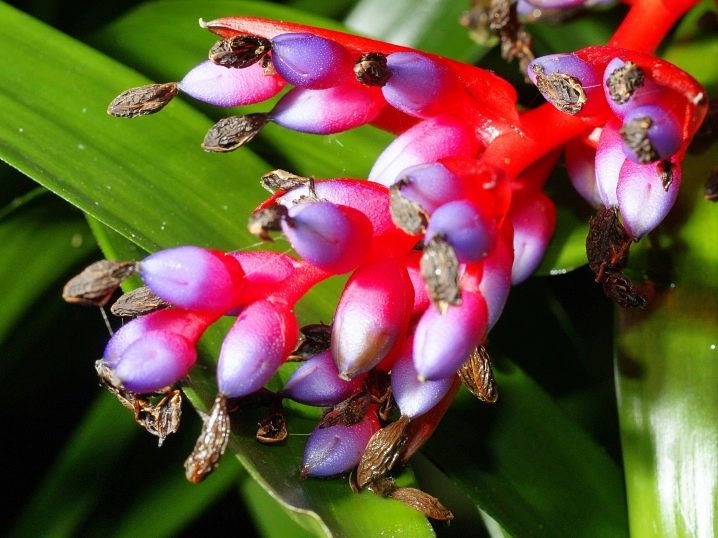
- Ehmeya curved. The flower has narrow-linear leaves, they can grow in a funnel. The leaf is 41 cm long and 1.6 cm wide. The inflorescence is 21 cm high. It has triangular bracts and pink flowers.

- Ehmeya sparkling. Leaves are strong, belt-like. The length of one leaf is about 41 centimeters, the width is 8 cm. The leaf has a dark green color, with silvery longitudinal stripes. On the inflorescence there are bracts of a coral tone and bluish-pink flowers.


- Ehmeya is holosteel. The leaves are short and dense, forming a funnel. Brown thorns are visible on their sides. The inflorescence looks like a spikelet, on top are scarlet bracts. There are small pinkish-yellow flowers at the top.
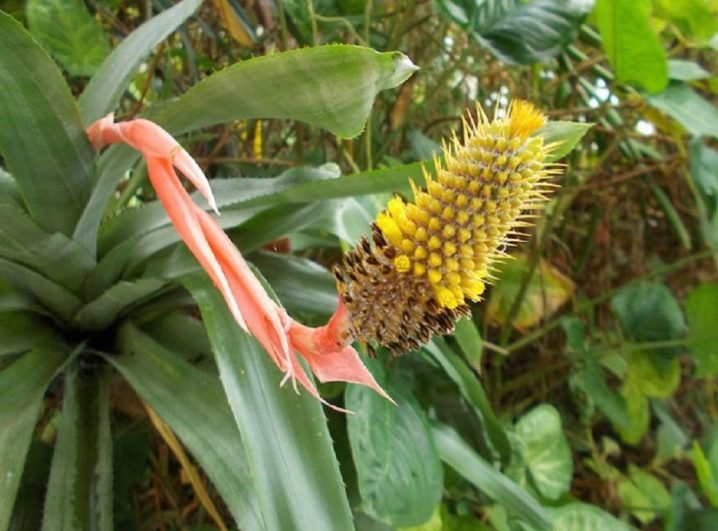
- Ehmeya striped "Primer"... It is an epiphytic flower that grows slowly. Its height ranges from 31 to 91 centimeters, and its width is 61 cm. The leaves are wide, 46-91 cm long, have a green color and wide silvery-white stripes with spots. Leaves can be collected in an outlet. The inflorescence is capitate, has red, purple bracts and spiny edges. The peduncle is straight, densely pubescent. The flowers are small, sessile, the petals are violet-blue.


- Blue Rhine. The flower is of considerable size. The rosette of the leaf can form a funnel. In nature, bromeliad accumulates liquid in the funnel, which is then mixed with various forest debris. As a result, hanging bogs can form on trees, and this variety can develop on them.

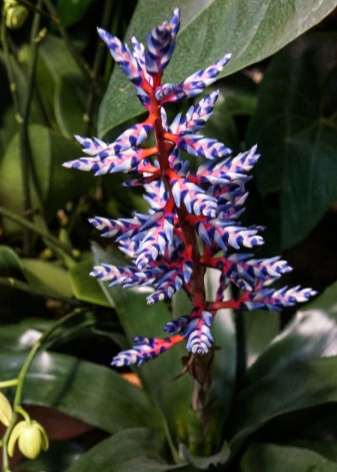
- "Blue Tango". This flower has dense, leathery, belt-like leaves that are collected in a funnel. A peduncle emerges from the funnel with a beautiful inflorescence of small flowers with bright blue tones. This variety is easy to grow at home.

- Ehmeya Queen Mary is a rare species. She also received the name "Queen of the Forests" The plant lives on the tops of tall trees in the coastal forests of the Caribbean coast of Costa Rica. The flower has a beautiful inflorescence. The cone is 51 cm long. It has bright pink stipules, which are 21 centimeters long.
This variety is rare, but recently it can be grown in botanical gardens using cuttings.
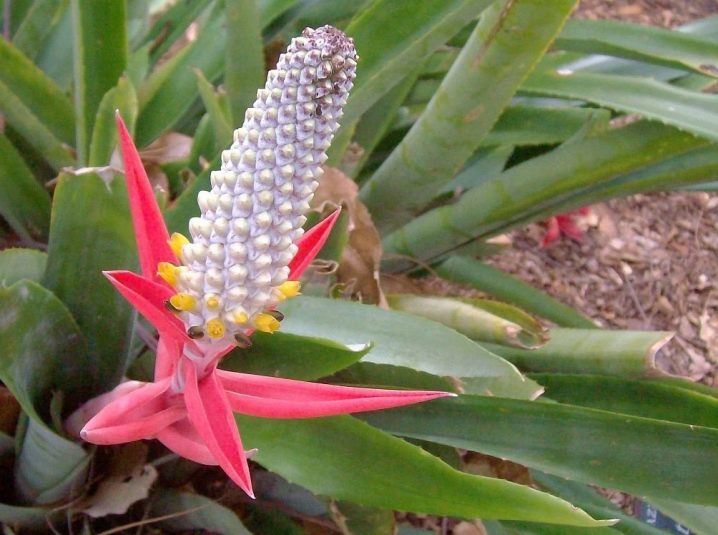
Terms of content
To grow ehmeya, it is necessary for her to create comfortable conditions.
Lighting
In lighting, this flower is unpretentious, as it can live well both in a bright room and in a slightly shady one. The eastern and western windowsills are considered a good place for the plant. But in order to more specifically determine the place of development of a flower, you need to pay attention to its leaves. If the leaves are harsh or sinewy, then the ehmeya must be placed directly in a lighted place on the southern windows, but so that they are not burned by the rays of the sun.
If it is a warm season, then it must be taken out into fresh air. If the flower has soft leaves, then the ehmeya should be placed in a penumbra room, where the lighting will be moderate.


Temperature and humidity
Ehmeya likes warm weather, even if there are daily temperature drops, she will be able to withstand them. If in the summer season the flower is indoors, then the air temperature in this place may suit her well. It is important to know that ehmeya will always need clean air.
In the summer, a suitable temperature for plant development is +21.28 degrees Celsius. It will be able to withstand even higher temperatures, but we must not forget about airing. In winter, the flower retires, so the temperature can be slightly reduced to + 18.19 ° C.
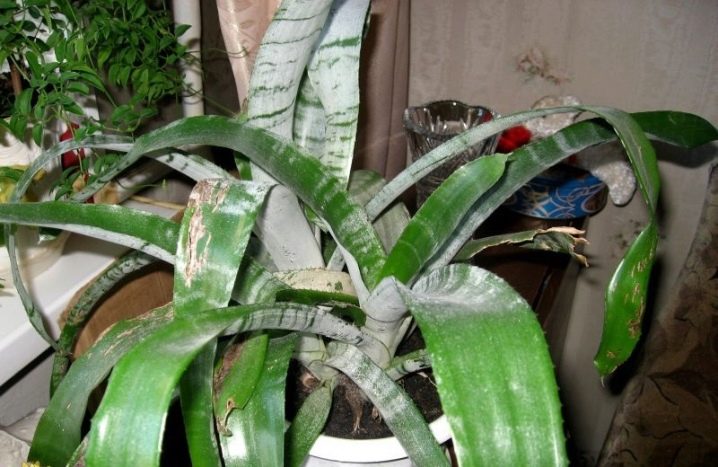
The air humidity should be high. In the morning, you need to spray the plant with a liquid that is at room temperature. In order for excess moisture to evaporate from the leaves, an open space is needed for a flower, in which there will always be good air movement. To increase the humidity, you can use a special pallet that has a grate. At the bottom of this pallet, you need to pour water, or surround the container with wet sphagnum moss.

Transfer
You need to transplant the flower as soon as spring begins. The container for the plant can be left the same or you can take 2-3 centimeters more. In a flower such as echmea, the root will grow more in width than in depth, and therefore it is not necessary to acquire a voluminous or deep pot. The main condition is that there must be a drainage hole at the bottom. To plant echmea, you can buy special soil for bromeliads. It is composed of peat, leafy earth and sand. To make the soil looser, you need to add pieces of bark, sphagnum moss and charcoal to it.
Before transplanting a flower into a new container, you need to carefully examine the roots and assess their condition. In general, a flower transplant does not have any difficult work, but if necessary, this process can be done every year.
It must be remembered that there are some species that have poisonous juices. Therefore, gloves must be worn when working with this flower, as irritation may appear on contact with the skin.


How to care?
Ehmeya is a wonderful plant, so you need to know all the rules for caring for it.
Watering
You need to know all the features of watering by seasons.
- In spring and summer. When the upper part of the soil in the container dries up, you need to water the plant well. Water must be carefully poured into a leaf outlet, and then moisten the soil. The liquid in the funnel must be changed 2 times in 30 days so that it cannot stagnate.To do this, you need to slightly tilt the flower, holding it well, and let the water flow, or you can blot the liquid with a rag. Water for irrigation should be settled and soft. The temperature should be above room temperature. Both dryness of the soil and too strong moisture should not be allowed.
- In autumn... In this season, it is necessary to gradually reduce watering.
- In winter... It is necessary to stop watering to the outlet when the temperature drops to +21 degrees. It is necessary to moisten the soil well, but make sure that the soil dries well as soon as watering ends.


Top dressing
For a plant to thrive, it needs nutrition. Top dressing should be started in March and stopped in October. As a top dressing, fertilizers are suitable, which are used for bromeliads and decorative flowering flowers. But these fertilizers need to be diluted with a liquid 2 times more than the norm. It is recommended to choose a mixture that does not contain copper and boron, as they are toxic for this type of flower.
Top dressing must be applied foliarly, as soon as the watering of the flower ends. And you can also spray the leaves, and pour the solution into the outlet. Fertilizers need to be applied 2 times in 30 days.
Gardeners can feed the ehmeya and at rest of the flower, but at the same time it is necessary to reduce the amount of fertilization: 1 time in 45 days.


Bloom
This flower blooms from May to October. Ehmeya can bloom only 1 time, and after that it will gradually fade away. But during flowering, daughter shoots will appear. A flower that is grown from seed will only bloom after 4 years. Ehmeya from daughter shoots will bloom after three years.
Flowering can take several months. But the plant itself will quickly fade, and the bracts will be able to hold on for some time. In order not to shorten the flowering time, you need to water the flower carefully, without wetting the bracts. As soon as the bract dries after some time, it must be cut almost under the base with a sharp pruner. The liquid from the pot must be removed - if this is not done, then the plant will rot and will not survive.
If the flower cannot bloom, then it must be forced. To do this, put a container with a flower in the bag, put 3 apples and oranges there. Next, you need to tie the bag well. This will release the aroma from the fruit, and the ehmeya will bloom for about 4 months.
But you also need to know that for a good effect of ethylene, the temperature should be around +23 degrees.

Reproduction
This flower can be propagated at home in two ways: by planting daughter shoots or using seeds.
An easier and more effective way is to plant the children. Ehmeya, which has bloomed, forms daughter shoots. The shoots should grow, their height should be half the height of the mother flower or be about 16 cm. And they should also have their own root system. The breeding process takes place in March.
- The flower with shoots must be well removed from the container.
- Using a sharp knife, it is necessary to separate the lateral processes with the roots. The place that was cut must be sprinkled with activated charcoal and dried.
- Prepare pots with a diameter of 8-10 centimeters. Fill them with a composition of two parts of leafy earth, 1 part of peat and 1 part of coarse sand.
- Plant daughter shoots and cover with a transparent oilcloth so that there is a greenhouse effect.
- Place the pots in a lighted and insulated space.
If by chance the daughter shoot was separated from the roots, then such a plant will not survive.

The seed method is unpopular and difficult. If you grow a flower from seeds, then ehmeya can lose its varietal properties. The rules for planting echmea seeds include a number of points.
- The pot must be filled with crushed peat or sphagnum moss.
- The seeds are not placed very deeply in the ground.
- Cover the top with a bag or a piece of glass.
- Place the pot in a place where direct sunlight will not fall.It is necessary to constantly moisten the soil and ventilate the room.
- The temperature should be at least +23.25 degrees Celsius.
- When 3 months have passed, seedlings will appear, and they will need to be dived. Mix in equal parts leaf and heather soil, using it for picking. Crops should be kept at a temperature of +21.23 degrees. And you also need to moisten the soil, and spray the flower.
- After a year, the grown flower must be transplanted into the soil mixture for the matured echmea flower.

Diseases and pests
If you take care of the plant incorrectly, then fungal and viral diseases will develop. And the flower must be constantly examined in order to know in advance: if there are pests, then it is necessary to take measures.
If insect pests are found, then you need to familiarize yourself with how to deal with them.
- Leaf spot - the top of the leaf is covered with round blisters, and after a while dark brown stripes or fungus may form on them. To avoid this, it is necessary to treat the leaves with a fungicide once a week, repeating this process 2 more times. For prevention, too humid air should not be allowed, you just need to properly ventilate the room, and not keep the flower in the shade.

- Fusarium - this is when the roots and leaves rot at the base. If you start the disease, the flower will die. It is necessary to adhere to the temperature norm and follow the watering rules. And even before planting a plant, the earth must be disinfected.

- Shield - the matured pest can settle under the brown-gray shell or in the leaf axils. The larvae can quickly master the flower. For prevention, you need to spray the plant with soap or tobacco solution so that young larvae do not appear. Adult pests should be removed with cotton wool soaked in soap or alcohol.


- If a root worm has settled on the plant, the root system begins to rot, the flower stops developing, the leaves will have a pale color, and then dry out. With the help of such means as "Aktara" or "Confidor", you can help the plant get rid of the pest. For prophylaxis, before transplanting, you need to examine the roots well and remove the damaged areas. The soil needs to be watered with Aktara solution.

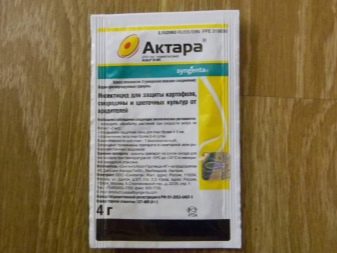
- If aphids settle on ehme, she can kill the flower if she sucks the juices out of it. If you do not take action in advance, the aphids can multiply abruptly. Therefore, you can spray the flower with lavender essential oil. And to process the soil.

Ehmeya is a beautiful and charming flower, the main thing is to know how to care for it and take good care of it.
For tips on caring for echmea, see the following video.
























The comment was sent successfully.